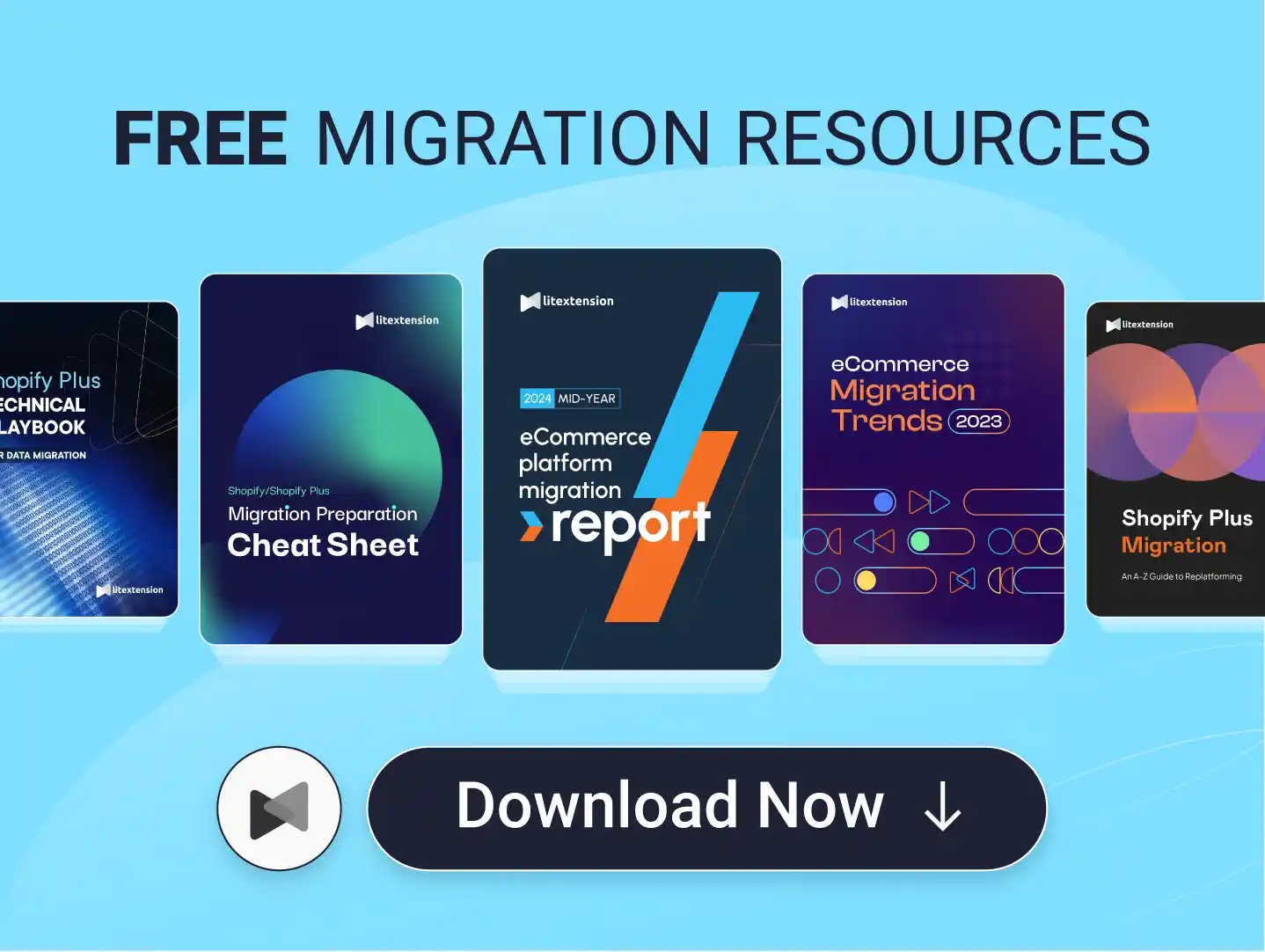The checkout experience is one of the most crucial steps in an online Shopify sale, and a long, complicated process is likely to lead to abandoned carts. Fortunately, with Shopify One Page Checkout, the payment process is conveniently simplified and eliminates all unnecessary friction for your customers.
Wondering how it works? No worries! In this guide, we’ll answer all your questions about the one page checkout Shopify, including:
- What is Shopify one page checkout
- Shopify one page checkout vs multi-page
- The key pros & cons
- How to change your Shopify one page checkout layout
- How to further elevate your Shopify checkout experience
- Busting the common myths
- 3 Shopify one page checkout examples to learn from
- Bonus Shopify apps
Without further ado, let’s dive in!
What Is Shopify One Page Checkout?
Shopify Onepage Checkout provides customers with a faster and more streamlined purchasing experience. Instead of navigating through multiple pages, shoppers can complete their purchases in a single step, reducing friction and making the process more efficient.
The platform offers this Shopify single page checkout system to shorten the path to purchase, which helps merchants minimize cart abandonment and boost conversions.
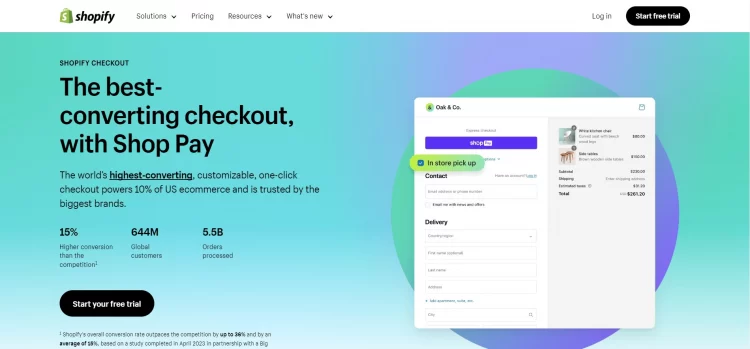
Are you new here? Well, then, we highly recommend you start with these hand-picked articles first:
- Shopify Flow Review: Is It Worth It for Your Business?
- How to Use Shopify Metafields: A Complete Guide
- How to Use Shopify Gift Cards to Drive Holiday Sales?
Is Shopify One Page Checkout or Multi-Page Better?
So, you’re wondering which Shopify checkout option is best: the one-page or the old-school multi-page version. Let’s break it down and see which one comes out on top!
Feature | One-Page Checkout (Now) | Multi-Page Checkout (Old) |
Speed | Faster, fewer clicks | Slower, multiple steps |
Mobile-Friendly | Optimized for quick purchases | More taps, longer process |
User Flow | Everything on one page | Step-by-step navigation |
Abandonment Risk | Lower: fewer steps = less friction | Higher: more pages = more drop-offs |
With the classic multi-page checkout, Shopify split the process into different steps: you had customer info, shipping details, payment, and then the order confirmation. For some people, this was a familiar, easy-to-follow structure, but let’s be honest—it also meant a lot of extra clicks, especially on mobile. Every time you switched to a new page, it felt like you were starting over, which could be a little frustrating.
Now, the one-page checkout is here to change the game! Instead of jumping between different pages, everything is laid out in one neat, streamlined form. That means fewer clicks and a smoother experience for your customers. And guess what? Because all the steps are right there, people are less likely to drop out halfway through the process. There are no more distractions or extra steps getting in the way of completing the sale.
Plus, the one-page checkout is super mobile-friendly. It’s optimized for quick, hassle-free purchases, which is a game-changer when so many people are shopping on their phones these days.
Verdict:
When it comes to which one is better, the one-page checkout definitely wins for most stores. It’s faster, easier to use, and reduces the chances of customers abandoning their carts.
Shopify One Page Checkout: All The Pros & Cons
Shopify one-page checkout Pros
The LitExtension team has extensively tested Shopify one page checkout to evaluate its impact. Based on our experience, here are the three biggest advantages of this streamlined Shopify 1 page checkout:
Streamline checkout process
By centralizing three checkout pages into one single screen, Shopify one page checkout saves your customers from navigating back and forth between multiple pages. This saves your customers valuable time and reduces any potential confusion.
Reduce cart abandonment
With fewer distractions along the way, customers are more likely to follow through with their purchase, thus reducing instances of cart abandonment.
Improve customer satisfaction
The streamlined experience offered by Shopify's one-page checkout directly contributes to improved customer satisfaction, as your customers can easily see all the necessary fields required for order completion without being overwhelmed by multi-page navigation.
Shopify one-page checkout Cons
Despite its several benefits, from our experience, there might be some limits to Shopify one page checkout. And since you cannot switch back to the three-page checkout, we will also show you how to overcome the setbacks of Shopify's one page checkout module.
Slow down site speed
Consolidating a significant amount of information onto a single page can lead to longer loading times, especially if the customer's device or internet connection is not particularly fast.
Overwhelm customers
Despite its intention to simplify, some customers may find it challenging to process all the required fields and details on a single page, leading to frustration. This is particularly true when the checkout page involves lengthy scrolling, which can further exacerbate user annoyance.
Pro tip: Reduce the number of unnecessary fields in your checkout form. Plus, enable Shop Pay to allow customers to check out with pre-filled data if you are valid for Shopify Payments.
Harder tracking
Consolidating all information onto a single page and within a single URL can make tracking and analyzing various aspects of user behavior difficult. It becomes challenging to pinpoint the exact stage at which customers abandon their transactions, hindering the ability to gather valuable insights for future development and optimization.
Pro tip: Add heatmap tools to your checkout page to track your customers checkout behavior and where they are most likely to drop off.
How To Change Your Shopify One Page Checkout Layout?
Now, let us walk you through 5 simple steps to modify your Shopify one page checkout layout and create a professional and user-friendly checkout experience:
Step 1: Select customer contact methods
To define how customers provide their contact details, go to “Settings”> “Checkout” in your Shopify admin. Next, decide whether your customers can check out using both phone numbers and emails or restrict it to emails only.

You can also:
- Enable the order tracking link for Shop to allow customers to download the Shop app from the order status page.
- Enable “Require customers to log in before checkout” (this will limit checkout to email users only).

Step 2: Customize customer information collection
Now, in the “Customer Information” section of the checkout editor, adjust the following settings:
- For Full Name: Choose between “Require first and last name” or “Only require last name.”
- For the remaining fields (Company Name, Address Line 2, and Shipping Address Phone Number): Set them as “Don't include,” “Optional,” or “Required” based on your needs.

Step 3: Configure marketing options
Remember that Shopify allows you to collect marketing consent at checkout. Specifically, in the “Marketing Options” section, you can enable Email and/or SMS marketing sign-ups by displaying a checkbox for customers to opt in.
- For email marketing, Shopify recommends displaying a preselected checkbox in certain countries (like the United States) or in specific regions you choose.
- If enabling SMS marketing, ensure you comply with SMS marketing regulations and have the required consent from customers.

Step 4: Enable tipping
Do you want to offer tipping options to your customers? In that case, simply scroll down to the “Tipping” section and tick the box for “Show tipping options at checkout.” Customers can select from three preset amounts or enter a custom tip based on their preference.

Step 5: Adjust address collection preferences
To streamline the checkout process further, you can determine whether Shopify should automatically use the shipping address as the billing address. Scroll to the “Address Collection Preferences,” then enable “Use the shipping address as the billing address by default.” Note that customers will still have the option to edit the billing address if needed.

Step 6: Set your checkout language
Next, move on to the “Checkout Language” section to select your preferred language. For further customization options regarding labels and page titles, click “Edit checkout content” to adjust them accordingly.
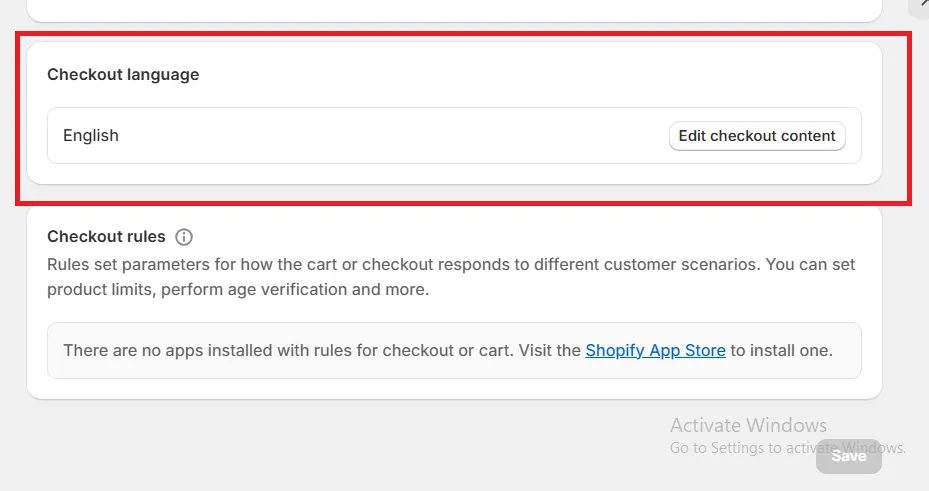
Step 7: Configure checkout rules (optional) and save the changes
Checkout rules help define how the checkout process responds to different customer scenarios. These usually include age verification, product limits, and cart restrictions.
As of this writing, Shopify does not provide built-in checkout rules. Nevertheless, you can install apps from the Shopify App Store to set parameters for your checkout experience.
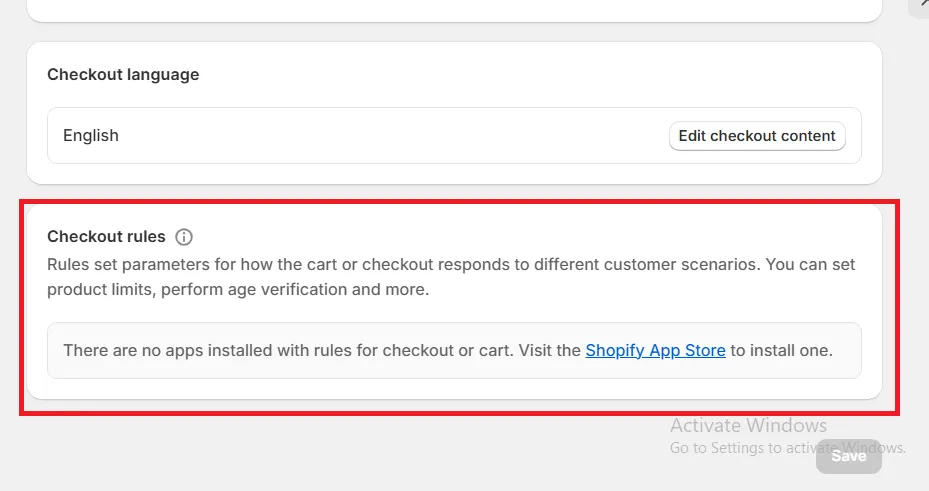
After completing all the changes, click “Save” to finalize your Shopify one page checkout. That's it!
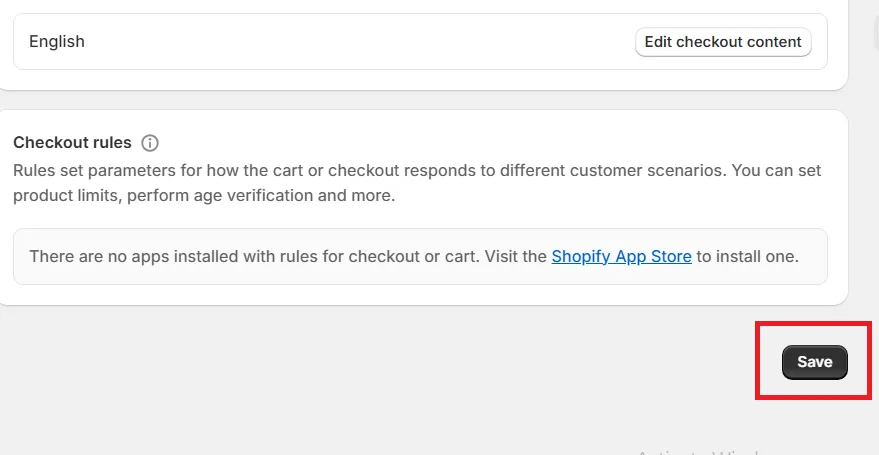
How To Further Elevate Your Shopify Checkout Experience?
With Shopify one-page checkout, your customers can check out more easily. However, there are still many things you can do to improve your Shopify’s checkout experience further.
From our experience, here are four tips you can do to optimize your Shopify checkout page:
#1. Simplify the checkout form
Review your checkout form and eliminate any unnecessary fields– only ask for essential information like shipping and billing details.
Plus, you can try to implement an auto-fill feature to help your customers complete the form more quickly. Besides, feel free to enable address lookup tools to minimize errors and speed up the process further.
#2. Introduce accelerated checkout options
Accelerated checkout options like Shop Pay, Apple Pay, and Google Pay make the checkout process faster and more convenient for customers. It will auto-fill your customers’ checkout information, saving them time on manual entry.
Hence, ensure you allow your customers to check out under these expeditious checkout options.
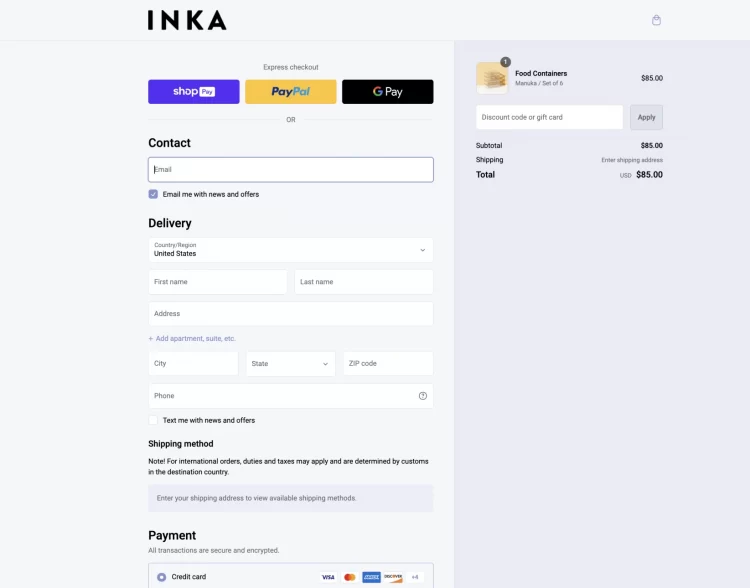
#3. Leverage post-purchase upsell
If you want to improve your customers’ checkout experience and increase your average order value, we highly advise you to upsell your customers at the checkout stage by offering them product suggestions that complement their initial purchases.
For example, when a customer buys a camera, you can offer them a discounted memory card or camera case.
#4. Be clear about pricing information
Hidden costs are among the top reasons that customers abandon their carts. Hence, clearly display the total order cost, including taxes and shipping fees, on the checkout page.
And don’t forget to provide clear explanations of any discounts, promo codes, or loyalty rewards that apply to the order. In that case, you can clear up any unnecessary confusion.
#5. Add Buy Now, Pay Later options
According to Insider Intelligence, Buy Now, Pay Later (BNPL) options have been all the rage around the globe in recent years, especially in the United States.
The percentages of buyers using BNPL increased year over year in all groups
Alt: US buy now pay later user penetration report
Therefore, if you are selling high-ticket products like electronics, jewelry, high-end cosmetics, etc., we highly recommend you add BNPL options to improve your customer checkout experience.
To name a few, you can enable Shop Pay installments, Klarna, or Sezzle to allow your customers to buy your products under installments.
Shopify One Page Checkout: Busting the Common Myths
Ever since Shopify one page checkout release date, there's been a lot of talk about Shopify's one page checkout, and not all of it is true. Let's cut through the noise and debunk the biggest myths:
Myth #1: “I'll lose valuable checkout data”
Some believe that a single page checkout Shopify means limited access to key customer insights. But let us tell you one thing: you're not missing out on anything!
In fact, Shopify still tracks all the key data from your checkout process; you'll get detailed analytics, conversion tracking, and customer behavior insights right in your Shopify admin. Even if you've set up custom tracking on your order status page, it will continue working without any issues.
So, if data is what's holding you back, don't sweat it. You're still in full control.
Myth #2: “It will slow down my website”
A lot of merchants fear that loading everything on one page will make checkout painfully slow.
However, you should keep in mind that checkout speed isn't just about layout. Performance depends on many factors like internet connection, browser, and device performance, not whether checkout is one page or three. To prove this, we tested Shopify stores with one-page checkout using Google's PageSpeed Insights and saw no noticeable slowdowns. In fact, many stores still passed Google's core web vitals test with flying colors.
So unless your website already has performance issues, Shopify's one-page checkout won't be affecting your store negatively.
Myth #3: “I'll lose my checkout customizations”
It's easy to assume that fewer pages mean fewer customization options. But the truth is that your custom branding, layout adjustments, and checkout modifications all carry over seamlessly.
Shopify designed the one-page checkout to support the same level of customization as the old multi-page version. You can still adjust colors, fonts, logos, and even add extra checkout fields — just like before.
3 Shopify One Page Checkout Examples To Learn From
#1. Kinship
Kinship is a US-based cosmetic retailer. They are among the first Shopify Plus brands that leverage the power of Shopify one-page checkout for its promising benefits. They have a full-fledged checkout page with custom branding, express checkout options, and BNPL options.
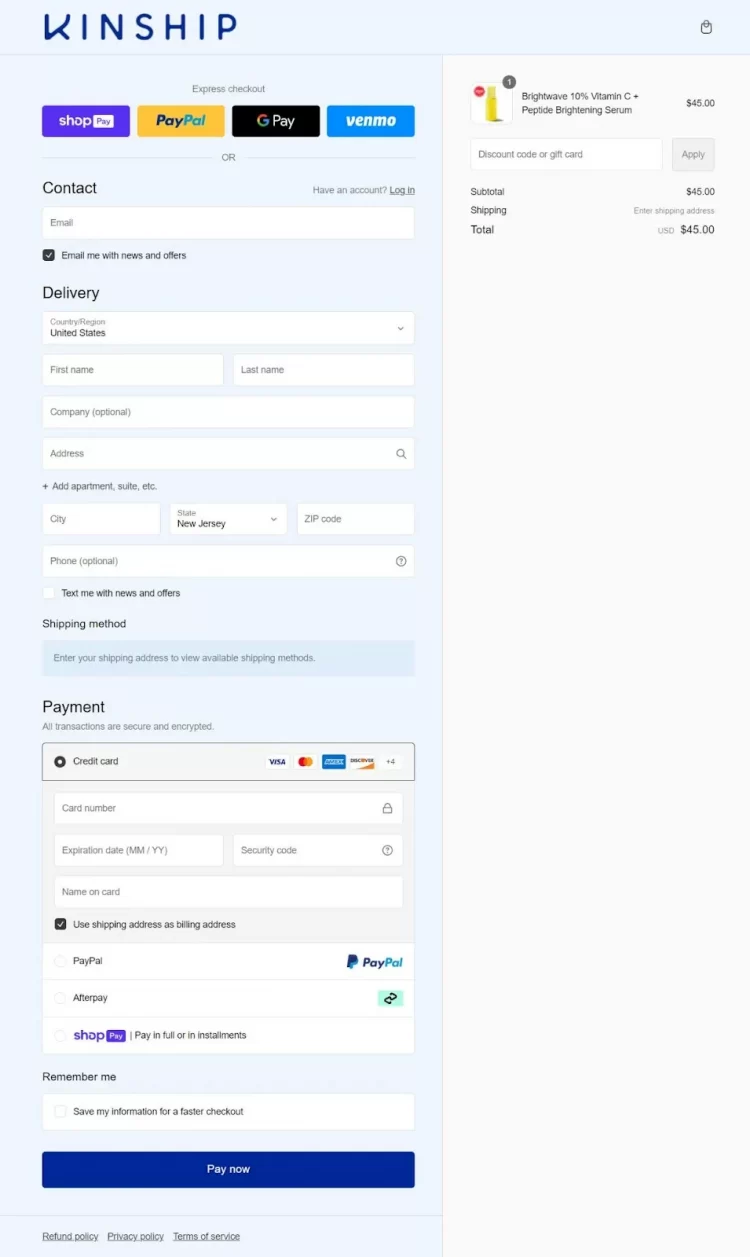
#2. Vacation
Vacation is a Shopify store selling sun-protection products. This website offers a stunning one-page checkout that we believe you can learn from besides Kinship. Their checkout page also hits all the right notes– beautiful branding paired with various payment options.
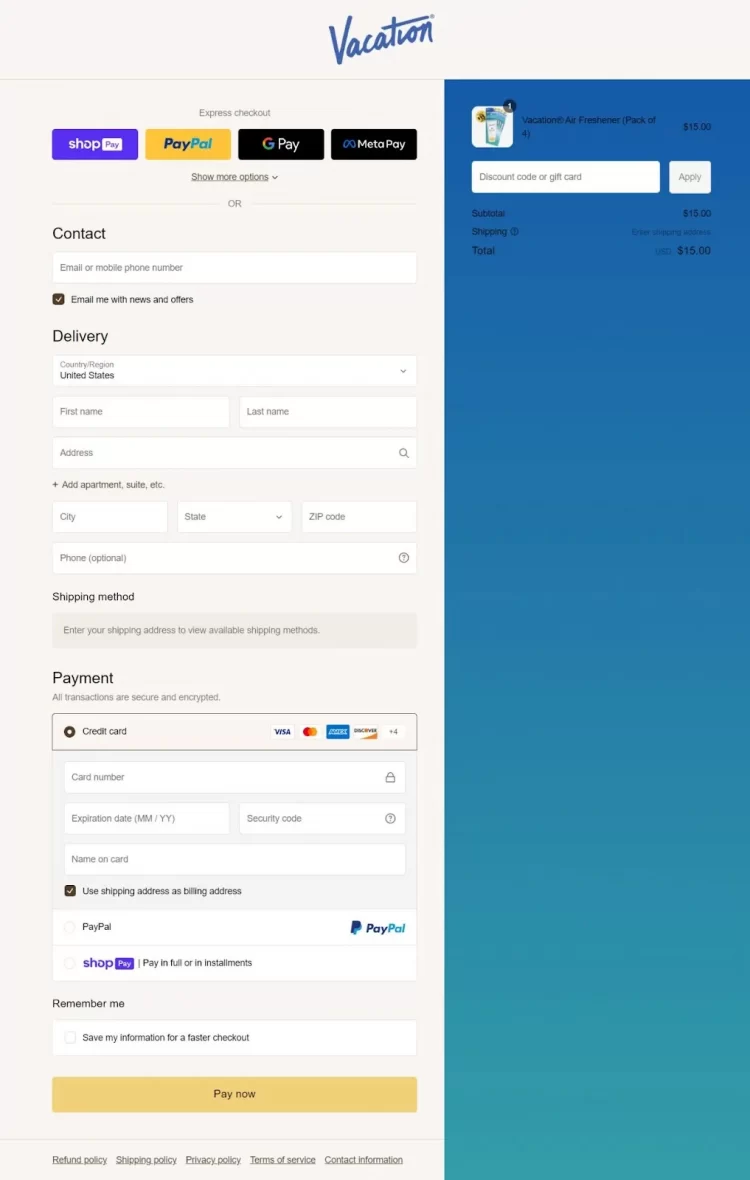
#3. Inka
Inka is a popular brand specializing in sustainable food ware. Inka is another prime example of brand that takes advantage of the brand-new Shopify one-page checkout to improve their checkout conversions.
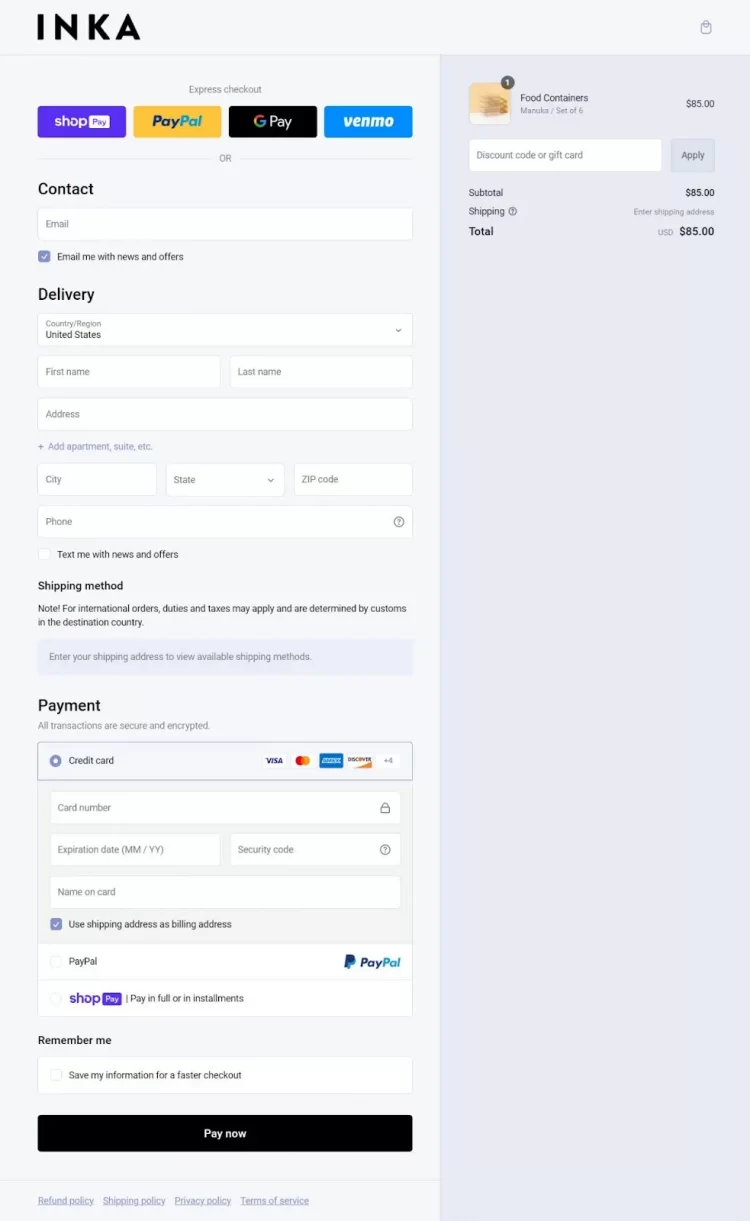
Bonus Reading: Shopify Apps to Enhance Your Checkout Experience
Want to further reduce cart abandonment and give customers a frictionless buying experience? These Shopify apps are here to help:
- AfterSell Post Purchase Upsell: Why stop selling after checkout? Keep the momentum going with one-click upsells and thank-you page offers, increasing your average order value effortlessly.
- Cartly Slide Cart Drawer: No one likes a clunky cart. That's why this app adds a sleek, slide-out cart with upsell prompts and discounts, which makes it easier (and more tempting) for customers to buy more.
- BOLD Upsell – AI Powered Upsells: Supercharge your sales with AI-driven upsell and cross-sell recommendations that appear at just the right moment to boost conversions.
- Shopify Checkout Blocks: Don't settle for a generic checkout page. This app lets you customize your checkout, thank-you, and order status pages to match your brand and improve the user experience.
- UpCart — Cart Drawer Cart Upsell: Take your cart to the next level with a sticky, slide-in cart featuring a free shipping bar and upsell widget, making it easy to drive higher order values.
Shopify One Page Checkout: FAQs
Does Shopify have single page checkout?
Yes, Shopify has a single-page checkout option that Shopify themselves just released on September 25, 2023, for merchants of all plans: Basic Shopify, Shopify, Advanced Shopify, and Shopify Plus.
How do I set up one page checkout on Shopify?
1. If you are a non-Plus user: Simply click "Settings" > Choose "Checkout" and start customizing your checkout form.
2. If you are a Plus user: You must be upgraded to checkout extensibility first, and then you can switch to a one page checkout in your checkout editor.
What is a one page checkout?
A one page checkout is a simplified checkout process that is merged into a single page/step. It typically contains fewer fields and is optimized to be as simple as possible.
Can I customize Shopify checkout page?
Yes, you can customize Shopify checkout page if you are a Shopify Plus user. Otherwise, you will need to rely on a third-party Shopify one page checkout app to do so.
How do I change one page checkout on Shopify?
Unless you are on Shopify Plus, the one-page checkout is the default, meaning you can't switch back to the old three-page checkout. Shopify has made this the standard experience for all non-Plus stores.
Final Thoughts
That’s it! Shopify one page checkout streamlines the checkout process and allows customers to complete their purchases faster than the multi-page version. Thanks to this efficient flow, merchants can now reduce friction and boost conversions.
And LitExtension hopes after reading this article, you can have all the latest information on Shopify single page checkout, how to enable it, and how to further elevate your checkout page.
Don’t forget to read LitExtension’s blog and join our active eCommerce Facebook Community to discuss and learn from 15,000 eCommerce entrepreneurs like you.
